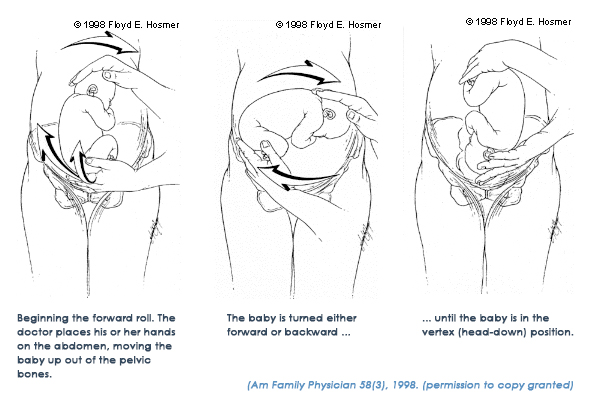Between 3 and 4% of babies are breech (buttocks and/or feet down, head up) late in pregnancy. Today there are very few physicians who will attempt a vaginal breech birth.
Therefore, the woman has these possible options:
- wait and hope the baby will turn spontaneously;
- self-help methods to encourage the baby to turn (including the breech tilt position, playing music through earphones placed low on the woman’s abdomen, having the father or partner lie with head in the woman’s lap and talk to the baby, etc.);
- the Webster technique, a chiropractic procedure that causes relaxation of uterine and pelvic structures, thus allowing the baby to turn;
- moxibustion, an acupuncture technique that may help between 32 and 36 weeks;
- homeopathic remedies;
- an external breech version at 36 to 38 weeks, in which a doctor attempts to turn the baby with his or her hands by pressing on the woman’s abdomen;
- a planned cesarean (if the baby has not turned).
If the other methods are not tried or are unsuccessful, then the woman may be offered a breech version. This procedure is successful approximately 65% of the time (more often with multiparas than nulliparas). The woman’s only chance for a vaginal birth may be with a successful version. There are risks (mainly that the baby cannot tolerate the procedure and needs a cesarean immediately), but these are very rare when it is done properly.
This paper describes the procedure, the challenges for the woman, and how a doula helps. The version will be uncomfortable to painful, but if the woman can relax and tolerate it, it is more likely to succeed than if she tenses or resists, and expresses pain. A doula’s role is to help the woman tolerate it, but it can be stopped at any time if the mother cannot handle it.How is cephalic version done?
Here is a description of the technique. Some doctors may not do it exactly this way, but it will be close to this description. (Few midwives perform versions. If they do, they usually do it earlier in pregnancy, and use a simpler technique.)
- The woman goes to the hospital. First she has a non-stress to see if the fetus is doing well, and an ultrasound to confirm that the fetus is breech. The doctor will explain the procedure and possible risks, so that the woman can make an informed choice.
- The woman may be given an injection of Terbutaline to relax her uterus. This causes a racing heartbeat and feelings of nervousness, but may make the version easier.
- With the woman lying on her back and her abdomen exposed, the doctor uses ultrasound to locate the placenta, and spreads lubricating gel over her abdomen.
- The illustrations on the next page show the doctor’s hand movements as he or she presses the baby around to a head-down presentation.
- Ultrasound is used frequently to assess changes in the baby’s position, and to check fetal heart tones to be sure the baby is tolerating the procedure.
- When done, the doctor uses ultrasound to confirm that the baby is head down, and a non-stress test is performed to be sure the baby is still doing well.

How does the doula help?
The doula prepares the woman: how the procedure is done, it may be painful, and it takes 5 to 20 minutes. She tells her the Terbutaline may cause nervous feelings. If the woman needs a break during the version, she can ask the doctor to pause. The doctor will stop moving the baby, but hold the baby still until the woman is ready to go on.
- The doula explains that the woman needs to try to relax, breathe in a light pattern, and look at the doula for help in keeping a rhythm. They might even rehearse the “Take Charge Routine” together before it starts. (If the woman and her partner prefer that the partner do the “Take Charge Routine”, the doula will use verbal encouragement and talk in the rhythm of the woman’s breathing: “That’s good…just like that…stay with it…good…”
- The atmosphere is tense and hopeful, but the doula is completely entrained on the woman.
- When it is over, the doula stays for awhile to process the experience, whether successful or not, and to be sure the baby weathered the procedure well.
In conclusion, the doula helps most by being kind, firm, confident in the woman, completely engaged with the woman, and persistent in helping the woman cope. In this way, the doula may help prevent some cesarean births, and empower her clients.
